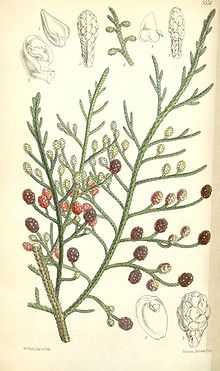Microcachrys
| Microcachrys tetragona | |
|---|---|
 | |
| Microcachrys tetragona, Illustration. | |
| Scientific classification | |
| Kingdom: | Plantae |
| Division: | Pinophyta |
| Class: | Pinopsida |
| Order: | Pinales |
| Family: | Podocarpaceae |
| Genus: | Microcachrys Hook.f. |
| Species: | M. tetragona |
| Binomial name | |
| Microcachrys tetragona (Hooker) Hook.f. | |
Microcachrys tetragona (Creeping Pine or Creeping Strawberry Pine) is a species of dioecious conifer belonging to the podocarp family (Podocarpaceae).[1] It is the sole species of the genus Microcachrys.[2] The plant is endemic to western Tasmania, where it is a low shrub growing to 1 m tall at high altitudes. Its leaves are scale-like, arranged (unusually for the Podocarpaceae) in opposite decussate pairs, superficially resembling those of the unrelated Diselma archeri (Cupressaceae). It shares the common name Creeping pine with several other plants. Females produce tiny, red, edible berries in summer.
Fossil record
Microcachrys has been called one of the most spectacular cases of a known relictual plant, being widespread in the past but now having a very restricted distribution.[3] The only extant species today, Microcachrys tetragona, produces a very distinctive pollen grain compared with other members of its family, Podocarpaceae, and records of fossil pollen from the genus have been recorded from all over the Southern Hemisphere throughout the Cenozoic, being found in Antarctica,[4] Australia,[5] the now sunken islands of the Ninetyeast Ridge of the Indian Ocean,[6] New Zealand,[7] southern Africa[8] and South America.[9]
The genus Microcachrys clearly had a very broad, Gondwanic distribution. But now, the sole surviving species, Microcachrys tetragona, is a shrub restricted to Tasmanian mountain thickets and boulder-fields.[10] The fossil record of Microcachrys is one of many compelling lines of evidence which points to the highly dynamic and changing Southern Hemisphere vegetation through the Cenozoic since the break up of Gondwana.
References
- ↑ Christopher N. Page. 1990. "Podocarpaceae" pages 332-346. In: Klaus Kubitzki (general editor); Karl U. Kramer and Peter S. Green (volume editors) The Families and Genera of Vascular Plants volume I. Springer-Verlag: Berlin;Heidelberg, Germany. ISBN 978-0-387-51794-0
- ↑ James E. Eckenwalder. 2009. Conifers of the World. Timber Press: Portland, OR, USA. ISBN 978-0-88192-974-4.
- ↑ Carpenter, Raymond J., et al. "Leaf fossils of the ancient Tasmanian relict Microcachrys (Podocarpaceae) from New Zealand." American Journal of Botany 98.7 (2011): 1164-1172
- ↑ Truswell, E. M., and M. K. Macphail. "Polar forests on the edge of extinction: what does the fossil spore and pollen evidence from East Antarctica say?." Australian Systematic Botany 22.2 (2009): 57-106.
- ↑ Macphail, M. K., N. F. Alley, E. M. Truswell, and I. R. K. Sluiter. 1994. Early Tertiary vegetation: evidence from spores and pollen. In R. S. Hill [ed.], History of the Australian vegetation: Cretaceous to Recent, 189–261. Cambridge University Press, Cambridge, UK.
- ↑ Kemp, E. M., and W. K. Harris. 1977. The palynology of early Tertiary sediments, Ninetyeast Ridge, Indian Ocean. Palaeontological Association of London. Special Papers in Palaeontology 19: 1–69.
- ↑ Raine, J. I., D. C. Mildenhall, and E. M. Kennedy. 2008. New Zealand fossil spores and pollen: an illustrated catalogue, 3rd ed. GNS Science Miscellaneous Series No. 4. GNS Science, Lower Hutt, New Zealand. Website http://www.gns.cri.nz/what/earthhist/fossils/ spore_pollen/catalog/index.htm [accessed 6 November 2010].
- ↑ Coetzee, J. A., and J. Muller. 1984. The phytogeographic significance of some extinct Gondwana pollen types from the Tertiary of the southwestern Cape (South Africa). Annals of the Missouri Botanical Garden 71: 1088–1099.
- ↑ Barreda, V. 1997. Palynomorph assemblage of the Chenque Formation, Late Oligocene?—Miocene from Golfo San Jorge Basin, Patagonia, Argentina. Part 2: Gymnosperm and colpate pollen. Ameghiniana 34: 81–92.
- ↑ Carpenter, Raymond J., et al. "Leaf fossils of the ancient Tasmanian relict Microcachrys (Podocarpaceae) from New Zealand." American Journal of Botany 98.7 (2011): 1164-1172
| Wikimedia Commons has media related to Microcachrys. |
| Wikispecies has information related to: Microcachrys |